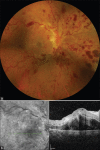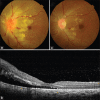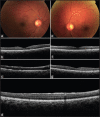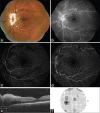COVID-19 and Eye: A Review of Ophthalmic Manifestations of COVID-19
- PMID: 33595463
- PMCID: PMC7942063
- DOI: 10.4103/ijo.IJO_297_21
COVID-19 and Eye: A Review of Ophthalmic Manifestations of COVID-19
Abstract
The pandemic caused by severe acute respiratory syndrome coronavirus 2 (SARS-CoV-2) has had health implications of unprecedented magnitude. The infection can range from asymptomatic, mild to life threatening respiratory distress. It can affect almost every organ of the body. Ophthalmologists world over are reporting various manifestations of the infection in the eye. This review was undertaken to help ophthalmologists recognize the possible manifestations and the stage of the viral disease when they commonly appear. Literature search was performed for the publications on ophthalmic manifestations of coronavirus disease-19 (COVID-19) between January 1, 2020 and January 31, 2021. 46 case reports, 8 case series, 11 cross sectional/cohort observational studies, 5 prospective interventional studies, 3 animal models/autopsy studies and 6 reviews/meta-analysis were included. Conjunctivitis is the most common manifestation and can develop at any stage of the disease. Direct effect due to virus, immune mediated tissue damage, activation of the coagulation cascade and prothrombotic state induced by the viral infection, the associated comorbidities and drugs used in the management are responsible for the findings in the eye. The viral ribonucleic acid (RNA) has been isolated from ocular tissues but the role of eye as a route for infection is yet to be substantiated. Ophthalmic manifestations may be the presenting feature of COVID-19 infection or they may develop several weeks after recovery. Ophthalmologists should be aware of the possible associations of ocular diseases with SARS-CoV-2 in order to ask relevant history, look for specific signs, advise appropriate tests and thereby mitigate the spread of infection as well as diagnose and initiate early treatment for life and vision threatening complications.
Keywords: COVID-19; SARS-CoV-2; central retinal artery occlusion; central retinal vein occlusion; cranial nerve palsy; follicular conjunctivitis; mucormycosis; ophthalmic manifestations; optic neuritis.
Conflict of interest statement
None
Figures











Comment in
-
Central retinal artery occlusion in COVID-19.Indian J Ophthalmol. 2021 Oct;69(10):2905-2906. doi: 10.4103/ijo.IJO_1803_21. Indian J Ophthalmol. 2021. PMID: 34571684 Free PMC article. No abstract available.
-
COVID-19 - associated third nerve palsy.Indian J Ophthalmol. 2021 Oct;69(10):2913-2915. doi: 10.4103/ijo.IJO_1619_21. Indian J Ophthalmol. 2021. PMID: 34571694 Free PMC article. No abstract available.
References
Publication types
MeSH terms
LinkOut - more resources
Full Text Sources
Other Literature Sources
Medical
Miscellaneous

